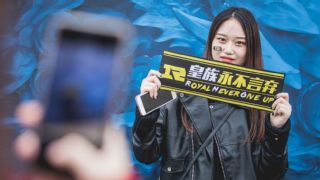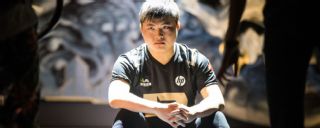|
WUHAN, CHINA -- Let's go back to Sept. 21, 2014, in Taipei, Taiwan. Star Horn Royal Club players are staring intently at the current match; Team SoloMid is sieging the tattered remains of SK Gaming's base. Damage comes down from Søren "Bjergsen" Bjerg's ultimate, but a Black Shield nullifies it. Royal's Yoon "Zero" Kyungsup stands up suddenly behind his teammates for a closer look. A binding catches TSM's Ham "Lustboy" Jangsik, and SK's Dennis "Svenskeren" Johnsen's Kha'Zix leaps through the air to finish him. SHRC's Jian "Uzi" Zihao raises his hands to celebrate. A reset allows Svenskeren to jump to his next TSM target for a double kill while SK's Adrian "CandyPanda" Wübbelmann darts in to finish the fight. After Royal had lost to Team SoloMid to open the day, the team would either face them again in a tiebreaker to determine the group's first seed, or TSM had to lose another game. When CandyPanda's Vayne heroics gave TSM a final score of 4-2, he would say he did it for his favorite AD carry, Uzi himself. That crucial No.1 seed was the difference between Star Horn Royal Club facing legendary team Samsung White and domestic rivals EDward Gaming in the quarterfinal. With Oh My God, the last all-Chinese team to attend a World Championship before 2017, 3-0'ing NaJin White Shield in the adjacent bracket, SHRC had the perfect formula for avoiding a South Korean team on its run to the Grand Final. With Choi "inSec" Inseok and Zero on the roster, SHRC would stand out as a shining example that the South Korean import experiment worked. SHRC beat both all-Chinese teams in the World Champion bracket stage in a best of five. When Christopher "MonteCristo" Mykles predicted that Oh My God would win the semifinal, he lamented that he should have known: two South Koreans are better than none.
Fast-forward to present day in Wuhan. Royal Never Give Up, the rebranded iteration of Star Horn, is the first all-Chinese League of Legends team to attend a World Championship since SHRC beat out EDG and OMG in 2014. Like then, Royal started the day dropping to the prominent western first seed in its group, G2 Esports. But unlike in 2014, RNG was put in complete control of its destiny in the final game of the day to come out first or second. The domestic crowd screams at the pivotal Baron fight when Uzi, not Svenskeren, gets the reset on Tristana, and members of the opposing team fall. Fervent chants of "RNG! RNG! RNG!" later follow the squad as it pours into the red side base and dismantles the enemy Nexus. "When I joined RNG," head coach Huang "FireFox" Tinghsiang told me at the end of the day, "I already knew Mata and Looper would be leaving. At that time, I knew it would be an all-Chinese team, and I would be really motivated." Three years after the last World Championship final appearance by the Royal organization, an all-domestic Chinese LoL team escaped Group Stage in first once again. In 2014, Royal made a Grand Final by avoiding all the South Korean teams until the last best-of-five. This time around, it ended up beating Samsung Galaxy, the third seed South Korean team, 2-0. "Beating Samsung [the first time] helped a lot for Uzi, xiaohu and Mlxg who had played against them last year," FireFox said. "They were pretty beaten up from last year and losing to them."  Going into the tournament, FireFox confessed, Royal Never Give Up, a lane-smashing squad, had a poor read on the meta. It benefited a lot from watching Play-Ins and learning from what it could already observe on stage. It had to slowly adapt to a compromise of late game scaling teamfighting and vision denial to still get the important picks necessary to close out. But the results were evident enough. With tailored LED lighting to support each individual member of the team, RNG gave its home crowd a show. With a loss that could have meant repeating Immortals' 0-4 implosion from the day before to lose its spot to G2 Esports, RNG rebounded with a daring Vayne-centric composition. Five AD carry bans graced the opening ban phase, and other options like Sivir remained to answer 1907 Fenerbahçe Esports' Tristana. With Lulu and Galio to reset engages and a heavy tank line, Vayne was still a risky pick, but it was a quintessential Uzi choice, and the lock-in resulted in the loudest cheers of the day. "I didn't think too much, Vayne was open, I just picked it," Uzi told the Chinese broadcast at the end of the match. The win qualified RNG for quarterfinals, but it wasn't content with just top eight; RNG had to prove a two-time win over Samsung made it more than just a fluke team that won with an overpowered Jarvan IV and Galio composition. RNG's final win over Samsung continued an important trend. The only teams in LoL Worlds history since 2013 to make it out of Group Stage above a South Korean squad have been all domestic rosters. Gambit Gaming and Fnatic bested Samsung Ozone in 2013. Flash Wolves overcame KOO Tigers in 2015. In 2017, Royal Never Give Up forced a jubilant home crowd into chanting fits. Security stood shoulder to shoulder along the front to prevent excited fans from attempting to climb the stage. Before I left Shanghai for Berlin earlier this year, the Summer Split of the League of Legends Pro League had only just begun. Royal Never Give Up struggled with rotating members of the roster. Li "xiaohu" Yuanhao was showing strain keeping wins next to the RNG name. I went to a final lunch with a member of the Chinese press. Disheartened by RNG's recent performance, he insisted he had moved on to Oh My God, the all-Chinese team that topped Group B at the time.  Months later, Lee "Crown" Minho, regarded as one of the best mid laners in the world, paid xiaohu his respects, praising him for all four games in which he has faced off against xiaohu on stage. "I look forward to any rematch against him," Crown said. The LPL spent years buying the best names and believing that it needed strong Korean talent to carry it to a World Championship. In 2017, Royal Never Give Up improved a roster that used to boast Cho "Mata" Sehyoung with a rookie Chinese support and a top laner benched from the roster for Jang "Looper" Hyeongseok the previous year. "It proves Chinese players can do it too," a member of the crowd with an Uzi headband insisted as the Fenerbahçe game ended. She spoke only of Royal's first win over Samsung, but she was confident, despite my skepticism, that there would be a repeat victory for the all-Chinese team. Even before the World Championship began, I heard whispers that teams are looking for primarily Mandarin Chinese speaking staff. Fluency in a single language will become a more valued tenant of roster building for the LPL in the coming year. It's "the Royal model." "One of my dreams is that, if RNG perform well this year, it can inspire other teams to move back to the all-Chinese rosters," FireFox told me at the end of the day. In 2014, Star Horn Royal Club's success started a wave of Korean imports. Holdovers still valuing communication in-game as a necessity had to buckle to the success SHRC demonstrated on the biggest stage in the world. It didn't matter that it hadn't taken more than a single game off a team from Champions Korea. OMG's 3-0 of NaJin White Shield was discredited and forgotten when Royal overcame it in the semifinal. OMG's 2015 collapse with Uzi himself on the roster just made it worse. In 2017, Royal defeated Samsung twice -- something it couldn't manage at all the year before with Mata and Looper in tow -- with an all-Chinese team. Humiliating defeats in the bracket stage can still unwrite RNG's legend, but for now, it has made its mark on domestic soil. And the entire World is standing for a closer look.
|

